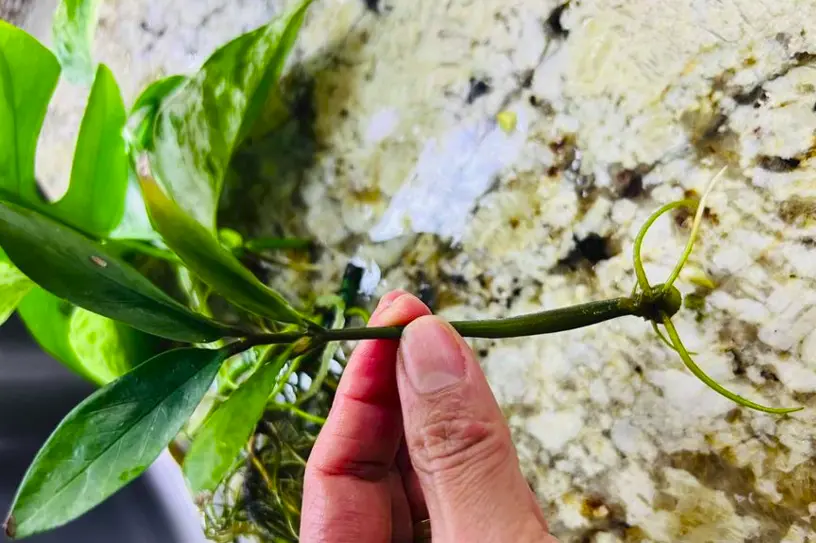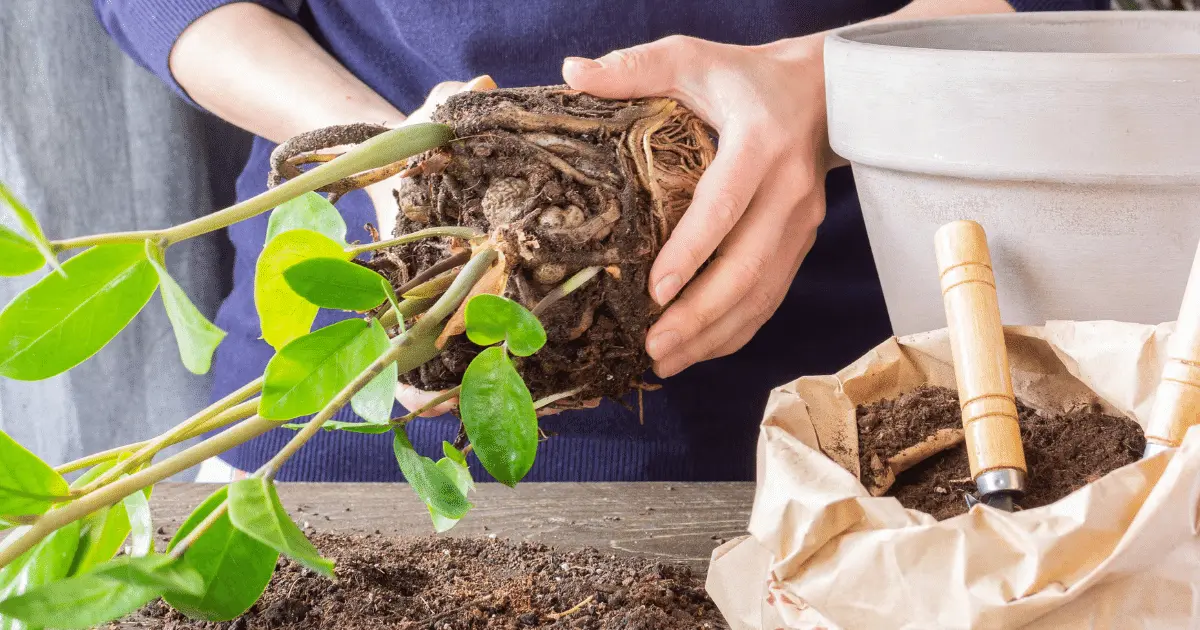Zamioculcas zamiifolia is a perennial flowering plant from Kenya’s tropical East African regions down to the Northeast of South Africa.
ZZ Plants also go by many aliases, such as the Zuzu Plant, Aroid Palm, Eternity Plant, Zanzibar Gem, and my favorite, The Emerald Palm.
They’re mainly propagated as decorative plants because of their gleaming and appealing foliage, unique root system, and their simpleness and forbearance of harsh environmental conditions.
Propagating your ZZ Plants
ZZ plants are best propagated from stem cuttings. This follows a simple line of action that is straightforward to perform.
Take a sharp, clean knife, garden shears, or scissors and cut out a mature stem off the mother plant. This stem must be up to 2 inches long, with good foliage.
Supposing the stem is long enough, you can divide them into smaller cuttings, each more than 2 inches long and two or three leaves growing.
Preparing the Stem Cuttings for Rooting

One important thing to know about propagating ZZ plants is that the process will test your patience; if you’re looking for a fully grown decorative plant for your home garden in a few weeks, you’ll have to try other plants.
Rooting the ZZ plant’s stem cuttings in water should take up to nine months while rooting in a Soil Potting Mix takes eight months.
The cuttings should be placed on a bare, warm, and dry surface for a few hours or up to three days until the cut edges are properly healed (calloused). It is essential only to root the cuttings once they’re fully calloused. Otherwise, the cuttings might get infected and begin to decay.
Rooting ZZ Stem Cuttings in Water
The stem cuttings in a water glass container look very appealing and are an excellent idea for decorating the home.
Rooting your ZZ cuttings in water is also easy to set up; get the transparent glass jar and pour in water up to three inches high.
The water level should be enough for root development to cover up the tips of the cuttings, not to immerse the entire cuttings.
Next, place a handful of the stem cuttings with their leaves still attached into the water jar; you should remove the leaves at the bottom of the cuttings before inserting them in water.
Ensure the upper leaves are well above the surface of the glass jar in an upright position to maximize sunlight reach.
Place the set-up in a warm environment, and remember to substitute the water in the jar every week.
Your cuttings are ready for transplanting once you observe fully developed root bulbs growing on them.
Rooting your ZZ Stem Cuttings in a Soil Mix Potting

A more direct method of rooting your stem cuttings is in a soil potting mix. Many propagators prefer this direct approach because it has a higher success rate of growing new ZZ plants and eliminates the need for transplanting, which can put the newly developed roots at risk.
A good practice is preparing the soil mix potting before preparing the stem cuttings.
Once your cuttings are ready, pluck off the lower leaves and wait until the stems are healed before potting.
I know of a trick to improve the quality of rooting in soil which involves dipping your calloused cuttings in honey or any rooting hormone at the tips, but that’s entirely at your discretion.
Next, pour the soil mix into the pot until almost filled, and make shallow holes on the surface. The holes should be at most one inch deep in loose soil.
Now insert the cuttings into the holes and stand them upright, with the leaves well above the surface; once done, fill up the empty spaces with more soil mix.
Watering should be delayed for at least a day, allowing the cuttings to adjust in their new home. Ensure there are holes all around the pot for efficient water drainage.
You don’t want the soil to get damp and sticky; keeping it moist is sufficient for the proper development of the new plant.
Propagating ZZ Plants from Leaf Cuttings
Leaf cuttings are known to have the lowest success rate in propagating ZZ plants. I recommend you go for stem cuttings, at least as a beginner.
But if you’re in for an experimental propagation, then hop in.
The process doesn’t require a law degree from Havard. You cut off samples of fully mature leaves from a mother plant and ensure the selected leaves are cut with their nodes fully developed.
Now spread the leaf cuttings on a dry, warm surface and allow the wounds to get healed. You can opt to root them in water or soil.
Rooting in water is a fantastic experience; you could journal the whole process as a vlogger, carrying your online community along.
Rooting ZZ Leaf Cuttings in Water
If you’re rooting in water, get your glass jar and pour in water up to 3/4 its volume. Next, place the leaves on the water’s surface, and keep watching.
The water should be changed periodically to maintain cleanliness and ensure the lighting conditions are favorable for the rooting process.
Rooting ZZ Leaf Cuttings in Soil
This follows the same method of rooting the stem cuttings. The leaves should be placed sparsely on the soil surface, with the soil mix always damp and protected from direct Sunlight.
You’ll know the leaves are finally developing roots once you see them pushing upwards out of the soil surface.
Propagating ZZ Plants by Division
Another simple method of propagating ZZ plants is dividing mature plants with well-developed foliage and rhizomes. This works well if your ZZ plant is becoming leggy and bushy.
Remove the plant from its pot and divide it through its sections, separating it from the root rhizomes. Ensure each rhizome has its network of stems and leaves.
Each new division can now be propagated in a unique pot, the same way you’d grow a stem cutting in soil Potting.
When correctly propagated and cared for, your new ZZ plants can continue detoxifying your home for more than ten years.
Watering your ZZ Plant
I heard a well-known saying among propagators: “watering your ZZ plant more than you pay your monthly rents is overwatering it.” Soon, I realized that’s not just funny; it’s pretty accurate.
At most, you should only water your ZZ plants once a month. A general rule of thumb is to only water when the soil looks dry up to an inch into the surface.
How much Sunlight does a ZZ Plant require?

Your ZZ plants flourish well in unlit environments, usually within homes and buildings. They’d instead remain indoors under indirect Sunlight but will also thrive in the full glare of the summer sunshine.
ZZ plants shouldn’t be propagated below 60°F (15°C). They grow optimally within a temperature range of 64°F to 79°F (18°C to 26°C).
You should ensure they get as much Sunshine as possible to keep their leaves brightly shiny and avoid chlorosis (yellowing and eventual falling off of leaves).
When the Sunlight is below its requirements, the plant experiences stunted and distorted growth as its stem is stretched in search of more lighting conditions.
Best Soil for ZZ Plant Propagation
ZZ plants love well-drained soil having good porousness and sufficient organic compounds.
A healthy soil mix for ZZ plants should include a combined formula comprising gardening soil, Perlite, garden charcoal, orchid bark.
The pH range should be moderately acidic between 6.0 and 6.5. Suppose it’s too much for you to prepare a preferred homemade soil mix.
Going for any commercial cactus or succulents soil mix will also provide the draining requirements to propagate the ZZ plants.
What is the Toxicity of ZZ Plants?
ZZ plants might cause irritations to the skin and eyes of people and animal pets because they contain calcium oxalate compounds.
I usually keep their pots at the least busy spots in my home garden and minimize direct contact with them as much as possible.
Scientific studies of their toxicity levels are still ongoing but largely inconclusive, meaning they’re not lethal to health.
Some symptoms of contact with ZZ plant toxins include vomiting, diarrhea (when the leaves are eaten), and stomach upsets. The symptoms are usually not fatal if treated immediately.
When is the best season to Propagate ZZ plants?
They’re best propagated from early fall to late summer, the growing season for most ornamental plants.
A ZZ plant’s root system is efficiently developed to thrive in droughts, where water availability is limited, and situations of excess watering. This makes it relatively easy to propagate, especially for a newbie or first-time propagator.
Its roots have swollen sections (rhizomes that look like potatoes) that store excess water and nutrients, giving the plant an advantage in harsh environmental conditions.
Considering that many Feng Shui and Vastu specialists believe that propagating ZZ plants in specific corners of the home brings good luck, fortune, stability, and prosperity, I’d say growing pots of ZZ plants to gift your friends and colleagues might be all the luck you need to build healthy and potentially mutually rewarding relationships.
